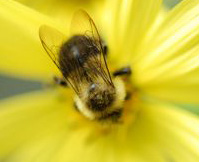|
Add a yard to your yard
~ Adapted from the Great
Sunflower Project
A bumblebee  | In a recent study conducted by the National Academy of Sciences, loss of habitat was identified as a major cause of the decline in the number and types of bees nationwide.
By planting for pollinators, we can rebuild pollinator habitat and make a significant, positive impact on the survival rates for honey bees and other pollinators. Whether urban, suburban or rural, pollinators rely on "key species" to obtain the vital nectar, pollen, and nesting resources they need to keep thriving. These key plants are critical for survival and can be incorporated easily into your garden.
If everyone added another square yard of habitat species to their gardens, just think of all the additional resources that would be available for bees to get what they need to give back what we depend on.
Here's how you can help pollinators in five easy steps:
1) Select a spot in your yard that gets sun and would look great with more flowering plants.
2)Measure a 3 foot x 3 foot section. You may have to remove turf, large rocks, or lawn furniture.
3) If necessary, add organic topsoil or compost and work it in.
4) Select plants that offer a variety of pollen and nectar throughout the season. Native plants are always a good choice.
Here a just a few of the many pollinator
plants that are easy to grow in CNY:
Sunflowers (Helianthus spp.)
Milkweeds (Asclepias spp.)
Coneflower (Echinacea purpurea)
Joe-pye (Eupatorium spp.)
Bee-balm (Monarda spp.)
Goldenrods (Solidago spp.)
Summersweet (Clethra alnifolia) (a shrub)
Pussy willow (Salix discolor) (a shrub)
5) Plant and enjoy the benefits of providing critical resources for pollinators in your garden. And don't forget to spend a few moments observing these interesting creatures. Most aren't aggressive at all and are fascinating to watch!
|